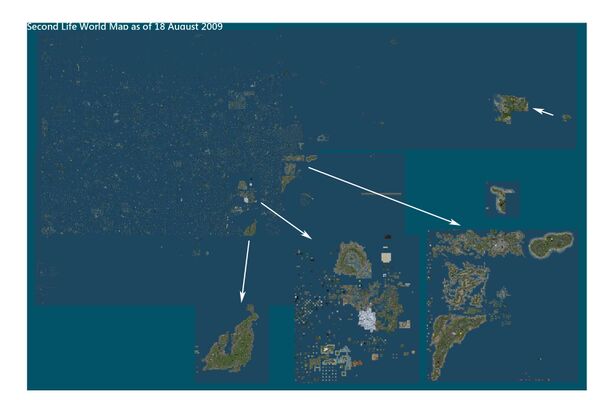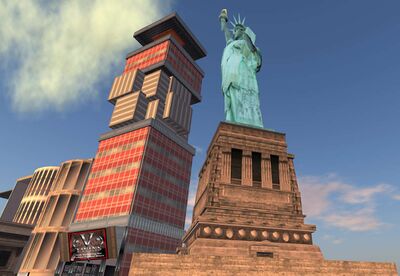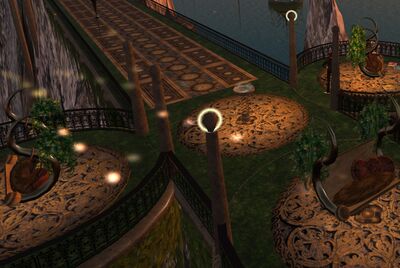Difference between revisions of "User's Manual"
| Line 162: | Line 162: | ||
==== Become a Virtual Land "Owner" ==== | ==== Become a Virtual Land "Owner" ==== | ||
==== Role Play ==== | |||
Unlike real life which limits the extent of presentation changes to represent a role, Second Life affords endless ways to represent a given role.[[Role_play]] | |||
== Footnotes == | == Footnotes == | ||
Revision as of 09:07, 19 August 2009
| Help Portal: |
Avatar | Bug Fixes | Communication | Community | Glossary | Land & Sim | Multimedia | Navigation | Object | Video Tutorials | Viewer | Wiki | Misc |
This "User's Manual" is intended to pull together basic information about Second Life in the style of a software manual. There is much more information available in this wiki and other sources, and links will be provided where possible.
Introduction
Second Life® is a virtual world filled with thousands of 3D places to explore that combines social interaction and 3D graphics in a unique way.
It features a huge amount of user-created content (270 TeraBytes), a convertible currency, and 750,000[1] active users doing almost everything imaginable.
In terms of virtual size and real Dollar economy, it ranks about 178th in the world, and in terms of population 160th.
The software download and account setup are free, although some things, most notably virtual land, have fees to use them.
Because this is the first virtual world of this size and complexity, the software is in continuous development. Occasional bugs, crashes, and downtime can be expected, and frequent software updates.
What You Need to Have a Second Life
Interacting with the Second Life virtual world requires the following:
(1) A Second Life account - Before you can log in, you have to set up an Account with a first and last name, and password. Accounts are available for people 18 years of age or older in the main Second Life area, and for those 13-17 years old in the Teen Second Life area.
(2) A Broadband Internet connection - A speed of 500 kilobits per second is the default software bandwidth. As a service with real time interaction, low latency (ping time) is important, preferably below 500 ms. Although satellite and terrestrial wireless are not officially supported, it is possible to use them. Dial-up is below the minimum bandwith setting of 50 kbps required for the 3D graphics, media streaming, and voice chat when logged in.
Also, typical bandwidth usage of 50-100MB per hour occur, which may be a factor for users with monthly download quotas.
(3) A computer capable of running the Viewer program - The System Requirements gives the details, but the basic idea is that the 3D graphics are generated in real time by your computer, and it has to have a fast enough graphics chip or card to do that. In turn, the rest of the computer system has to be able to support the graphics.
The settings within the Viewer can accommodate a wide range of computer systems. If you are using one at the low end of the system requirements, your 3D view will not be as pretty, but it can be made to work.
Although not noted in the system requirements, about 500MB of hard drive space is needed to install the software, and store downloaded data when you run it.
(4) Installing the Viewer program - Versions are available for Windows, Mac, and Linux. Windows XP and Vista are currently supported. In addition to the official version, there is a joint open source viewer (Snowglobe), and an assortment of open source third party viewers.
(5) Web browser installed - Some features such as account information are accessed on the web (as is this wiki page). The viewer has a built-in web browser which can be used.
Optionally you may use:
(6) A microphone for voice interaction
(7) Joystick or 3D mouse as a control device
Basic Concepts
Since Second Life is not like any other 3D environment, some basic concepts paticular to it are reviewed in this section. More words are defined in the Glossary.
The Grid - A set of servers hosting connected map regions plus supporting databases and networking. Together they make it possible for a user to log in, see, and interact with the 3D world. The main SL Grid is called Agni. See Grid.
Map Region - Each server on the agni.secondlife.com domain runs several copies of a "Simulator" program, each of which represents one 256x256 meter area of the grid. When you move from one region to another, you are handed off from one server to another, giving the impression of a large 3D world. Currently the main (Agni) grid has about 29,000 map regions.
Technically a map region is a set of data, like a document, or spreadsheet, which can be saved, and reloaded if a server stops running. The Simulator program is constantly updating the data in real time, as users come and go, objects are added and removed, scripts running within the objects do things, etc. Map regions are also sometimes called 'sims' after the program that runs them. However, that term is deprecated and therefor shouldn't be used, in order to avoid confusion. See sim for more details.
Viewer - The program that runs on your computer that connects via the internet to the Second Life servers. It allows you to log in to the grid and then see and interact with objects and avatars around your current "location" in the virtual world.
Resident - An account that most Second Life users have, with a first and last name, profile, account balance, inventory, etc. See Resident.
Avatar - The character that represents a Resident when logged into Second Life, and appears on the 3D view area. Avatars are highly customizable. See Avatar.
Linden Lab - The company that owns Second Life. See Linden Lab.
Linden - Staff member of Linden Lab. Their accounts have the last name "Linden". For example, "Philip Linden" is the account used by Philip Rosedale, founder and Chairman of Linden Lab. See Linden.
User-Created Content - Linden Lab codes the software and hosts the servers that runs Second Life. But most of the items you see when you are logged in are actually created by other users, such as clothes, furniture, weapons, animations, sounds, etc.
The Viewer
The Viewer provides a 3D interactive view, and additional menus, buttons, and windows to perform various functions. It uses your graphics card or chip to generate the 3D view that you see in real time. The data to produce the 3D view has to be downloaded from the servers as you need it for two reasons: First, the total data for the main grid is over 270 Terabytes[2], and second, it changes constantly. This is different than most online games, where the data is provided mostly on an installation disk.
As you travel from place to place, the servers send you data for an area around your current location out to a maximum 'draw distance' you have set. Within that distance, there will be an initial fast download of the area around you so you can see it, then slower updates as things change: other avatars come and go, and objects move and change. More details can be found on these pages:
Getting started with Second Life Has basic information on downloading, installing, and using the viewer software.
Viewer menu - Has information on the six standard drop-down menus that appear on the top left of the screen
Advanced Menu - Has information on the two optional drop-down menus that can be turned on: Advanced and Admin.
Context Menu - These appear when you right click in the 3D view area. Depending on what the mouse was pointing at, the menus will change.
Inventory Menu - The inventory floating window which lists the inventory of items you own has it's own set of drop-down and context menus.
Floating Windows - Many buttons and menu choices open a 'floating window' which appears on top of the the 3D view area. They appear to 'float' over the 3D view, and can be moved around to suit.
The Website
Some parts of the Second Life service are accessed via the website rather than the 3D viewer program. Both the website and viewer use the same account first and last name, and password to log in.
Some of the more important pages include:
- Second Life: Official Site - The main home page. The bottom of that page has links to many of the more important pages.
- Second Life: Join - New account registration page.
- Second Life: Your Account - Summary of your account, with links to other account functions
- Second Life Blogs - Official communications from Linden Staff
Community
- SL Forums - Discussion forums. Some Linden Staff post here.
Support
- Downloads - Where to get the Viewer software
Things to Do
Once you are all set up, there are many things you can do. Where you go and what you do are up to you, much as you can surf the web and use it for whatever you choose. There is not a goal, or way to "win" Second Life as there is in some online games, even though it uses similar graphics technology.
Some of the things you can do and hints about how to go about them are listed below.
Meet Other People from Around the World
This can be done anywhere, and any time. Second Life has users from around the world, although certain times of day are more popular for particular real life countries.
Finding People on the Grid - The main grid (shown at left) has nearly 29,000 regions, and the online population varies from 40 to 75 thousand depending on time of day. That works out to 1.4 to 2.6 avatars per map region, which is not very crowded. To find people, you need to seek them out. This can be done in several ways:
- Using the Search button > Places tab. Search for a type of place such as clubs. They are listed in order by traffic score, which is player-minutes per day. High scores mean more players on average.
- Using the World Map, with the Resident check box activated. Online residents will appear as green dots. A cluster of dots is a group of users in one place.
- Using Events and Groups. Look for something you are interested in, and show up at a scheduled event, or join a group that interests you.
Talking to People Once you Find Them - There are numerous ways to communicate with people in Second Life:
- Local Chat - Text typed in the lower toolbar can be seen by anyone within 20 meters
- Instant Messages - Private text chat with one or more people which work anywhere in SL
- Group Chat - Text chat with anyone in a group you belong to who is online
- Voice Chat - Uses a microphone for live conversations
Play Tourist
- Travel the Grid - Second Life is a 3D simulated environment. A number of real world places have been rebuilt here, as well as many more that cannot exist in the real world. Click the photos below for larger versions. The web links will take you to the SL map, from which you can go directly to the location within Second Life.
WTC Memorial & Statue of Liberty
- Take Pictures
You can take high resolution photos in Second Life. Click this image to see the full 2000x3000 pixel version:
Go Shopping
Listen to Music and Watch Videos
Customize Your Avatar
Join Interest Groups
Create Your Own Items
Become a Virtual Land "Owner"
Role Play
Unlike real life which limits the extent of presentation changes to represent a role, Second Life affords endless ways to represent a given role.Role_play
Footnotes
- ↑ SLCC Keynote Presentation Mark Kingdon (M Linden), CEO of Linden Lab, 17 Aug 2009, slide 77
- ↑ SLCC Keynote Presentation Mark Kingdon (M Linden), CEO of Linden Lab, 17 Aug 2009, slide 78


